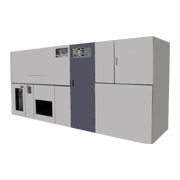Kanji (Chinese characters) came into use in the information processing field after 1975. In the area of data communication, Nippon Telegraph and Telephone Public Corporation (now NTT) planned for the adoption of kanji processing in collaborative systems such as DRESS, DEMOS, the Joint-Use Hospital Information System, and other national projects. There was a need for a practical kanji printer with a high printing speed of 15,000 lines/min for use in computer centers.
The Electrical Communication Laboratories (ECL) of NTT had good prospects of achieving such a device by applying previously developed technology for electrophotographic recording, high-speed heat fixation, and high-speed paper handling. Work began in March 1978. Various technologies were developed to achieve higher speed: improvement of optic writing speed via high-speed rotation of a rotating mirror, increased speed of developer transport and stirring, faster fixation by using an improved preheater, increased speed of paper handling, and increased speed of data processing in the equipment. At the same time, efforts were made to achieve shared use with format printing and alphanumeric/kana printers and thereby obtain a broader range of applicability by enhancing multi-functionality. In June 1979, NTT conducted standalone testing, continuous testing, and system connection testing; the results confirmed that the developed printer was fit for practical use. It was completed in October 1979.
This printer attained the then highest printing speed in the world—1.5 times that of the fastest commercially available printer at the time. Many of these printers were used at the DIPS Centers of NTT and were also widely used as commercial printers.


